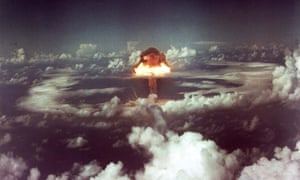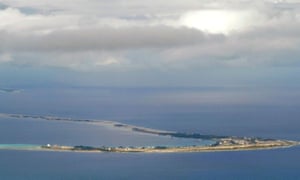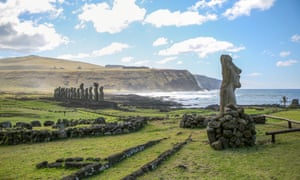If nuclear war broke out where's the safest place on Earth?
Nuclear tensions appear to be mounting again amidst political upheaval. So if the event of nuclear war, where should you head?

The recent death of Fidel Castro – a man synonymous with the threat of nuclear war and the Cuban Missile Crisis – has reminded us how much the world has changed since the end of the Cold War.
We are safer now than perhaps any time in our history. Let’s take the cheery topic of violent death, for example. In most of the world, murder rates are falling along with other violent crimes. A recent UN study reported that homicide rates in North America, Europe and Asia have been declining for last 15 years, and wars have also become less deadly when compared to conflicts in the 20th century. Even contemporary atrocities in the Middle East do not compare to the industrial genocide of Stalin, Mao, or Hitler. Research by the Early Warning Project for example, has shown a clear decline in mass killings in wars and conflicts since 1992.
Despite gruesome on-going conflicts, as a planet we are arguably living in the most peaceful time in human history. On the surface, that goes for nuclear threats too. Nuclear bunkers have been turned into nightclubs, civil defence has become an interesting historical curiosity, and the five countries of the “nuclear club” have successfully adhered to major international treaties that ban making and testing nuclear weapons for over two decades.
A mutually-assured obsession
Recently however, the atomic landscape has begun to shift. North Korea has undertaken a series of nuclear tests, including its fifth and largest detonation in September 2016, and the UN Security Council will soon be implementing sanctions, which could have wide-reaching consequences. Although the vast majority of UN member states voted in favour of a ban on nuclear weapons, there are increased tensions between NATO and Russia, continuing volatility between India and Pakistan, and new nuclear nightmares and geopolitical scenarios that never existed during the halcyon days of the Cold War.
Ex-Pentagon chief William Perry claimed this year that nuclear destruction is a bigger risk today than during the 70s and 80s. The shock election of Donald Trump, described by US military officers as ‘easily baited and quick to lash out’, has also revived our atomic anxiety. With Donald soon to be in sole command of 7,000 nuclear warheads, are we one step closer to nuclear annihilation?
Being the cheerful optimists that we are, we decided to explore how attitudes have changed towards nuclear deterrence, the current emotional geopolitics attached to nuclear weapons, and to consider what would happen in the basically impossible scenario that an instantaneous and multilateral nuclear war occurs in 2017.

So what is it about nuclear weapons that provoke such a strong emotional response? One only has to look at the debates over Trident renewal this year to see how nuclear issues can still incite such passion, anger and hostility. Global society has constructed a norm against the use of nuclear arms, but like any human construction, it can be repurposed. The idea that nuclear weapons have a unique psychological effect emerged following the bombings of Hiroshima and Nagasaki during WW2. Since then, nuclear things have possessed an exceptional political power, and atomic bombs became the ultimate taboo weapon.
When the British Government published its infamous September Dossier in 2002 to justify the illegal invasion of Iraq, they drew upon the powerful stigma of nuclear weapons, by including an atomic threat among a long list of – now debunked – reasons to invade. Though other weapons of war can be equally damaging, they do not hold the same emotional stigma as ‘The Bomb’. Even gas – rightly stigmatized after WW1 - has recently been deployed against civilians in Syria with little military backlash. It is doubtful that Obama’s weak response to this outrage would have been so anodyne (remember the ‘red line’, anyone?) if the Syrian Army had used tactical nukes.
But what would happen if there was a nuclear war today? We thought there was one way to find out - by modelling a simultaneous and multilateral contemporary nuclear apocalypse, to look at the safe places that emerge, and consider the meaning of it. We modelled one possible scenario for January 20th 2017, which just happens to be Donald Trump’s inauguration date.
We looked at the current international nuclear stockpile of the ten nuclear states for guidance, and considered the likelihood of conflict with other nations, to create a ranking of risk trajectories. Combining this with numerical weather prediction data enabled us to gain an approximate idea of what could happen if we had an all-out nuclear war. The modelled output of our crude atomic plaything produced fallout across the world, which would eventually plunge us into a nuclear winter.
So where is the safest place?
Our computer modelling shows that should atomic annihilation be on the cards, one of the safest places to live would be Antarctica. Not only is this sub-zero continent miles from anywhere, it was also the sight of the world’s first nuclear arms agreement in 1959. The Antarctic Treaty banned the detonation of all nuclear weapons and dedicated this frozen landscape as a space for peaceful research. But who’d want to live there? It wouldn’t be the first time polar regions have been used as nuclear hideouts: in perhaps the coolest mission of the Cold War, codenamed ‘Project Iceworm’, a huge nuclear base was secretly buried deep within the Arctic Circle. Known as “the city under the ice”, this vast bunker, which is now full of abandoned toxic waste and radioactive coolant, will soon be disentombed from its frozen lair as the icecaps continue to melt. So if Antarctica doesn’t take your fancy, where else?
Another option would be Easter Island in the South Pacific, over 2000 miles from South America. While spending time here as the rest of the world burns, you could check out the massive mysterious statues, known as Mo‘ai. These monoliths were carved by ancient Polynesians who cut down all the trees on the island in order to move these giant stone figures. Sadly, as Jared Diamond writes in his book ‘Collapse: How Societies Choose to Fail or Survive’, this deforestation turned the isolated island into an ecological ruin. What better place to ponder the hamstrung future of mankind than an island that encapsulates our ability to kill ourselves through damaging our environment?

If Easter Island’s barren landscape sounds too depressing, why not try the archipelagos of Kiribati or the Marshall Islands? These remote and sunny island chains come complete with tropical beaches and are surrounded by 750,000 square miles of ocean. Once the home to much of the historical nuclear weapons testing, it is somehow poignant that sites that were previously peppered with fallout could be the safest places on earth during our hypothetical nuclear apocalypse.
Whist we have geologically defined our atomic Anthropocene by our nuclear weapons testing, the future of humanity and the fabric of the planet is now being tested and moulded by pollution and climate change. Perhaps now it is time to reconsider the emotional connections that we have designated to nuclear weapons, since Hiroshima and Nagasaki. We need to think ourselves beyond the psychology of atomic apocalypse, if humanity is to survive.
Dr Becky Alexis-Martin is based at the University of Southampton, Dr Thom Daviesis based at the University of Warwick.
No comments:
Post a Comment